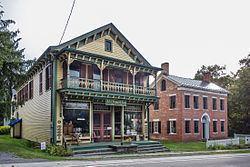Country United States County Greene Area code(s) 518 Elevation 282 m Population 2,725 (2010) | State New York Time zone Eastern (EST) (UTC-5) FIPS code 36-21204 Zip code 12422 Local time Wednesday 2:07 AM | |
 | ||
Weather 7°C, Wind SE at 6 km/h, 91% Humidity | ||
Blackthorn guest ranch east durham new york resort reviews
Durham is a town in Greene County, New York, United States. The population was 2,725 at the 2010 census. The town was named after Durham, Connecticut, and is in the northwest corner of Greene County.
Contents
- Blackthorn guest ranch east durham new york resort reviews
- Map of Durham NY USA
- History
- Geography
- Demographics
- Communities and locations in Durham
- Notable people
- References
Map of Durham, NY, USA
History
The land that would become the town was first settled around 1755 within Albany County. The town was established from part of the town of Coxsackie in 1790 as the "Town of Freehold". In the spring of 1800 Freehold became part of the newly formed Greene County. The town's name was changed to "Durham" in 1805, the town having been called informally "New Durham" by the many settlers from Connecticut.
Part of the town was lost in 1803 to form the new towns of Cairo, Greenville, and Windham. In 1836, the western part of Durham became the town of Conesville in Schoharie County.
The first documented visit to the Durham area was by Eliab Youmans, who had been commissioned to survey the Maitland patents in 1767. Undoubtedly explorers, hunters, and trappers preceded Youmans, but their travels were unrecorded. The patents were the first official parceling out of the largely unclaimed land and were the precursors to settlement. Eight patents have been identified for lands that were in, or partly in the town of Durham.
Historically, the Maitland Patent is the one most often cited, despite the fact that it was not one of the first grants. The grant, which was the first to lie exclusively in the future town of Durham, is historically significant as being the location for land described in the first known recorded lease in Durham and thus contains the first documentation for the initial settlement of the town. This patent of 5,000 acres (2,000 ha) was made to Colonel Richard Maitland, a British army officer of Scottish birth. The patent encompassed land that now includes the Oak Hill area as well as surrounding farmland leased by the earliest settlers. The first known lease was to Lucas DeWitt, dated May 3, 1774, for property in "DeWittsburg". The language of that lease suggests an occupation of the land by the earlier settlers, perhaps by 1771. In the early nineteenth century, Oak Hill matured into a vigorous industrial hamlet with highly productive mills and many fashionable homes.
The establishment of the first settlement in Durham is credited to three men, Lucas DeWitt, John Plank, and Hendrick Plank. These pioneers established homes at what was then called DeWittsburg, now Oak Hill. The American Revolution forced the pioneers to temporarily abandon their homes until the end of the war. Hendrick Plank was abducted by the Native Americans and removed to Canada, where he died in captivity. The two remaining pioneers and Hendrick's widow, who remarried to Leonard Patrie, all returned by about 1782 to reestablish their homes. DeWitt brought with him a small hand mill for grinding grain and was in one respect the first miller in the town as well as being a farmer.
Geography
According to the United States Census Bureau, the town has a total area of 49.3 square miles (128 km2), of which 49.2 square miles (127 km2) is land and 0.04 square miles (0.10 km2), or 0.04%, is water.
The north town line is the border of Albany County, and part of the west town line is the border of Schoharie County.
Demographics
As of the census of 2010, there were 2,725 people, 1,152 households, and 770 families residing in the town. The population density was 55.3 people per square mile (21.4/km²). There were 1,807 housing units at an average density of 36.7 per square mile (14.2/km²). The racial makeup of the town was 97.5% White, 0.6% African American, 0.03% Native American, 0.22% Asian, 0.3% from other races, and 1.2% from two or more races. Hispanic or Latino of any race were 2.3% of the population.
There were 1,152 households out of which 24.0% had children under the age of 18 living with them, 49.7% were married couples living together, 10.9% had a female householder with no husband present, and 22.5% were non-families. 25.2% of all households were made up of individuals and 34.5% had someone living alone who was 65 years of age or older. The average household size was 2.37 and the average family size was 2.82.
In the town, the population was spread out with 22.6% of people the age of 19 or younger, 4.5% from 20 to 24, 24.0% from 25 to 44, 33.4% from 45 to 64, and 20.4% who were 65 years of age or older (555 people age 65 and older). The median age was 46 years. For every 100 males there were 98.2 females. For every 100 males age 18 and over, there were 99.3 females.
The 2014 American Community Survey reports that median income for a household in the town was $41,944, and the median income for a family was $59,655. About 10.5% of families and 12.0% of the population were below the poverty line, including 17.3% of those under age 18 and 5.7% of those age 65 or over.
